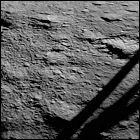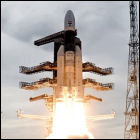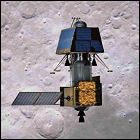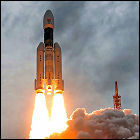Chandrayaan-3 lands on the moon
 Launched by ISRO (Indian Space Research Organisation) in July, the Chandrayaan-3 uncrewed lunar lander successfully touches down on the surface of the moon near the lunar south pole, the first human-made spacecraft to successfully land in that region. Pictures from the surface are transmitted back to Earth, though the lander’s mission is to look for signs of subsurface water believed to be common in the shaded south pole region, a potentially vital resource for long-term human habitation of the moon. (This was the mission intended for the earlier, unsuccessful Chandrayaan-2 mission in 2018.) In accomplishing this feat, India becomes the fourth country to soft-land a payload on the lunar surface.
Launched by ISRO (Indian Space Research Organisation) in July, the Chandrayaan-3 uncrewed lunar lander successfully touches down on the surface of the moon near the lunar south pole, the first human-made spacecraft to successfully land in that region. Pictures from the surface are transmitted back to Earth, though the lander’s mission is to look for signs of subsurface water believed to be common in the shaded south pole region, a potentially vital resource for long-term human habitation of the moon. (This was the mission intended for the earlier, unsuccessful Chandrayaan-2 mission in 2018.) In accomplishing this feat, India becomes the fourth country to soft-land a payload on the lunar surface.
Chandrayaan-3
 India launches the Chandrayaan-3 uncrewed lunar lander mission, expected to reach the moon in August after weeks of gradually increasing the vehicle’s orbital altitude until it slips from Earth orbit into lunar orbit. The mission profile is very similar to that of the Chandrayaan-2 mission, which attempted to put a lunar lander named Vikram on the surface near the lunar south pole to look for signs of water.
India launches the Chandrayaan-3 uncrewed lunar lander mission, expected to reach the moon in August after weeks of gradually increasing the vehicle’s orbital altitude until it slips from Earth orbit into lunar orbit. The mission profile is very similar to that of the Chandrayaan-2 mission, which attempted to put a lunar lander named Vikram on the surface near the lunar south pole to look for signs of water.
India’s Vikram lunar lander falls silent
 India’s mission to safely put a lander and an autonomous rover on the surface of the moon ends with a sudden loss of data. Deployed by the successful Chandrayaan-2 orbiter, the Vikram lander (carrying the Pragyan rover) begins a powered descent to the lunar surface, only to cease communicating with ground controllers in India at an altitude of 2.1 kilometers. With the speed of Vikram’s descent at the time of data loss measured at 60 meters per second via telemetry, ground controllers declare it likely that Vikram crashed into the moon, resulting in the loss of the vehicle and its payload, a fate somewhat similar to that of the Israel-launched Beresheet lander earlier in the year. The orbiter continues to function, and will search for signs of water ice at the south pole of the moon.
India’s mission to safely put a lander and an autonomous rover on the surface of the moon ends with a sudden loss of data. Deployed by the successful Chandrayaan-2 orbiter, the Vikram lander (carrying the Pragyan rover) begins a powered descent to the lunar surface, only to cease communicating with ground controllers in India at an altitude of 2.1 kilometers. With the speed of Vikram’s descent at the time of data loss measured at 60 meters per second via telemetry, ground controllers declare it likely that Vikram crashed into the moon, resulting in the loss of the vehicle and its payload, a fate somewhat similar to that of the Israel-launched Beresheet lander earlier in the year. The orbiter continues to function, and will search for signs of water ice at the south pole of the moon.
Chandrayaan-2 mission launched
 ISRO, India’s space agency, launches the Chandrayaan-2 mission to Earth’s moon, consisting of an orbiter and the Vikram/Prgyan lander/rover combination. The robotic vehicles are intended to conduct measurements, both from orbit and on the surface, of possible water ice deposits believed to exist at the lunar south pole. Much like the Beresheet mission launched by Israel earlier in the year, Chandrayaan-2 will employ a series of orbit-raising maneuvers until its apogee is high enough to propel it into lunar orbit with minimum reliance on burning fuel. The landing is expected to take place in September 2019.
ISRO, India’s space agency, launches the Chandrayaan-2 mission to Earth’s moon, consisting of an orbiter and the Vikram/Prgyan lander/rover combination. The robotic vehicles are intended to conduct measurements, both from orbit and on the surface, of possible water ice deposits believed to exist at the lunar south pole. Much like the Beresheet mission launched by Israel earlier in the year, Chandrayaan-2 will employ a series of orbit-raising maneuvers until its apogee is high enough to propel it into lunar orbit with minimum reliance on burning fuel. The landing is expected to take place in September 2019.